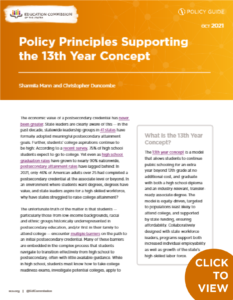State leaders are looking to increase postsecondary credential attainment to build the depth and breadth of their high-skilled labor force, and the concept of the 13th year has emerged as a model that can help do just that. The 13th year allows students to continue public schooling for an extra year beyond 12th grade at no additional cost, and graduate with both a high school diploma and an industry-relevant, transfer-ready associate degree. Based on our research, there are four policy principles that are key to widescale implementation of the 13th year concept:
- Equitable student access.
- High-quality programs.
- Robust student support.
- Cross-sector program design.
This Policy Guide explores these four principles and outlines examples in Colorado, Texas and Washington, which have codified policies that create a permissive policy landscape for 13th year implementation.



